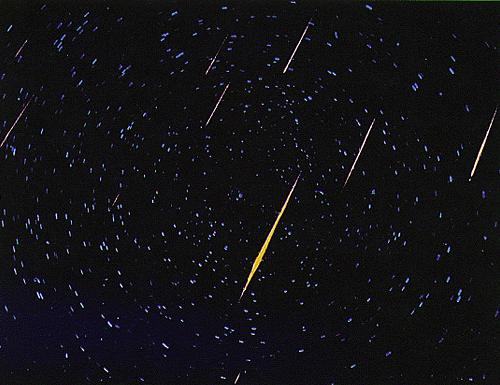The moon is not expected to interfere, so pale meteors will also be seen

On the night between Tuesday and Wednesday next week, the sky will be flooded with an impressive meteor shower. The meteor shower called "Leonides" - named after the constellation Leo from which they come - will reach its peak on the night between Tuesday and Wednesday 17-18.11.09 shortly after midnight. The rate of meteors during peak time will range from 150 meteors to 500 meteors per hour and it promises a beautiful celestial spectacle. Although the real big peak, at least according to the NASA website, is expected to be seen at its best from East Asia.
Professor Yoav Yair from the Department of Natural Sciences at the Open University explains: "A meteor shower is created when the Earth moving in its annual orbit around the Sun reaches an area in space where remains of the tail of a comet are found. Comets are quite large space glaciers (between 10 and 40 km) that come from the ends of the solar system, and when they approach the sun they heat up, the ice evaporates and the comets shed huge amounts of gases and dust particles. The reaction of sunlight and solar wind particles with the dust and gas from the comet causes them to glow and create the huge tail and halo that accompany every comet."
"The Leonids are remnants of the tail of Comet Temple-Tuttle, which orbits the Sun in an elliptical orbit every 33 years. This year the Earth passes very close to the "remnants" left over from the passage of 1344. The small fragments left since then will enter the high atmosphere and decay in it at an altitude of 100-90 km, leaving behind short and luminous paths, which they call "shooting stars".
Prof. Yair and his students plan to go down to Mitzpe Wiz in Mitzpe-Ramon and photograph the meter with calibrated cameras. The study of the light emitted during the passage through the atmosphere can provide clues about the chemical composition of the comet fragments. It is known that these are ancient substances from the beginning of the solar system, and recently NASA scientists announced the discovery of the compound glycine in tiny fragments collected by the Stardust spacecraft. This finding supports one of the interesting hypotheses about the origin of the first organic substances on Earth, that is, they arrived on the backs of comets.
So what to do in order to watch the meteor shower?
First: a clear, cloudless sky. Second, direct your gaze towards the south (where Leo is found). Third, a comfortable chair with a headrest, a blanket against the cold, and patience. No special equipment is needed, preferably a dark place free from light pollution. The recommended hours are after midnight.

8 תגובות
Hello everyone!!!!
I'm 10 years old and you know I've never seen a meteor shower!!!!!
Although I once tried, but I fell asleep in my room before the purifying shower!!!!
And even though I'm 10 years old, I teach her astronomy and you too to learn about it
Florin from me!!!!!!
Oof, I only saw clouds..
Does anyone have any pictures or anything?
I can't see anything!!
Hello everyone
Does anyone have a cloud forecast in the Ramon Crater area?
Is anyone traveling?
According to the Jewish religion, it is customary to bless meteors: "Blessed... doing an act of Genesis", and bless only the first meteor seen that night.
my beauty Only it didn't rain and clouds
The first eruption of the meteors is expected at 23:45 p.m. which may even be an hour earlier, so it is desirable to be in the field already at 22:00 p.m. and get organized
Let's hope for suitable weather
Sabdarmish Yehuda
The Israeli Astronomical Society